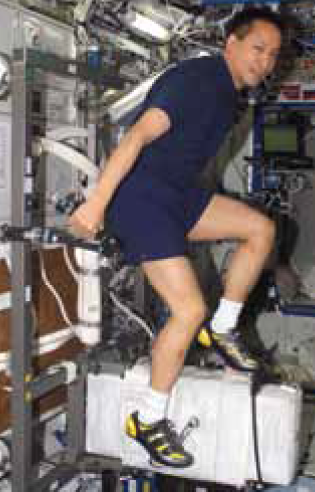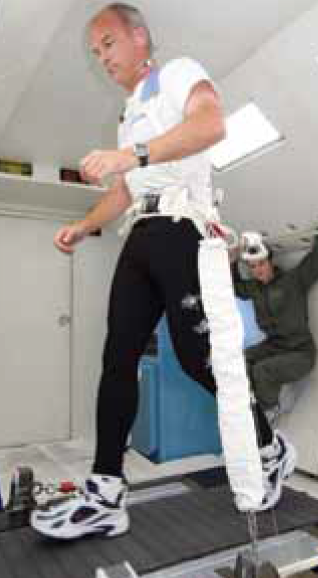Here on Earth, we're constantly using certain muscles to support ourselves against the force of gravity. But for astronauts on manned missions, the absence of gravity aboard a spacecraft makes moving physically undemanding.
Because astronauts work in a weightless environment, little muscle contraction is needed to support their bodies. Without regular exercise, muscles such as the calves, quadriceps, and those in the back and neck can weaken and deteriorate. The loss of physical strength can be extremely dangerous, especially if an astronaut must perform an emergency procedure while re-entering the Earth's gravitational field. Studies have shown that astronauts experience up to a 20% loss of muscle mass on spaceflights lasting five to 11 days. So while working gravity-free in space, what do they do to keep their muscles from deteriorating?
Astronauts aboard the International Space Station (ISS) exercise, and they do so intensively for two and a half hours a day. There's exercise equipment aboard the ISS, and each machine has different uses to combat the many effects of muscle atrophy.
The Advanced Resistive Exercise Device (ARED) maintains muscle strength and mass in astronauts during long periods in space. It uses adjustable resistance piston-driven vacuum cylinders and a flywheel system to simulate free-weight exercises in normal gravity. Without workouts like the ones possible on the ARED, astronauts are at risk of losing up to 15% of their muscle volume, which is difficult, or even impossible, to regain back on Earth. The ARED can exercise all major muscle groups while focusing on squats, dead lifts, and calf rises. This device provides up to 600 pounds and has a touchscreen to make it easy for crewmembers to follow a personalized plan.

ARED maintains muscle strength and mass in astronauts during long periods in space.
For aerobic and cardiovascular conditioning, the Cycle Ergometer with Vibration Isolation System (CEVIS) provides the ability for recumbent cycling. CEVIS also has the capability to support pre-breath activities, periodic fitness evaluations, and pre-landing fitness evaluations.

CEVIS provides the ability for recumbent cycling aboard the ISS.
To collect data such as body loading, duration of session, and speed for crewmembers, the Combined Operational Load Bearing External Resistive Exercise Treadmill (COLBERT) gives astronauts the freedom to run. It was built to handle 150,000 miles of running, and was also designed to not shake the rest of the ISS, or disturb delicate experiments taking place in the weightless environment.

COLBERT was specially designed for astronauts aboard the ISS.
Unfortunately, even with lots exercise, astronauts still suffer from small amounts of bone loss while in space. Scientists have been studying various ways to reverse the problem. For example, if an astronaut stood on a vibrating plate for about 20 minutes a day while working, it may decrease the amount of bone loss in space since this can mimic the effect of bearing weight. NASA researchers have even suggested rotating entire shuttles or stations to create a gravitational force to overcome bone loss in astronauts.
For more information on keeping in shape aboard the International Space Station, and to learn more about living in space, download the research paper below.

Want to go behind the scenes with NASA? Littelfuse has created an Exploration & Discovery Experience for the engineering community as part of its 2013 Speed2Design program. Winning design engineers will get the opportunity to spend time with NASA engineers at two NASA facilities and learn about the latest in space technology. For more information and to enter, visit speed2design.com.
Advertisement
Learn more about Electronic Products MagazineNasa





